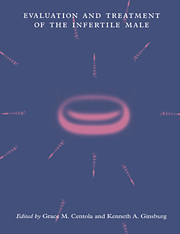Book contents
- Frontmatter
- Contents
- Preface
- List of contributors
- 1 Andrology
- 2 Sperm–egg interaction
- 3 Routine semen analysis
- 4 Computer-aided sperm analysis: a critical review
- 5 Antisperm antibodies: diagnosis and treatment
- 6 The sperm penetration assay
- 7 Intrauterine insemination for male factor
- 8 Processing human semen for insemination: comparison of methods
- 9 New assays for evaluating sperm function
- 10 Assisted reproductive technology for male factor infertility
- 11 Microinjection techniques for male infertility
- 12 Therapeutic donor insemination: screening, indications and technique
- 13 Endocrine assessment and hormone treatment of the infertile male
- 14 The urologic evaluation of the infertile male
- 15 Azoospermia: the diagnosis and treatment
- 16 White blood cells in semen and their impact on fertility
- 17 Psychological aspects of male infertility: lifting the shroud of shame
- 18 Evaluation of the female partner
- Index
3 - Routine semen analysis
Published online by Cambridge University Press: 16 September 2009
- Frontmatter
- Contents
- Preface
- List of contributors
- 1 Andrology
- 2 Sperm–egg interaction
- 3 Routine semen analysis
- 4 Computer-aided sperm analysis: a critical review
- 5 Antisperm antibodies: diagnosis and treatment
- 6 The sperm penetration assay
- 7 Intrauterine insemination for male factor
- 8 Processing human semen for insemination: comparison of methods
- 9 New assays for evaluating sperm function
- 10 Assisted reproductive technology for male factor infertility
- 11 Microinjection techniques for male infertility
- 12 Therapeutic donor insemination: screening, indications and technique
- 13 Endocrine assessment and hormone treatment of the infertile male
- 14 The urologic evaluation of the infertile male
- 15 Azoospermia: the diagnosis and treatment
- 16 White blood cells in semen and their impact on fertility
- 17 Psychological aspects of male infertility: lifting the shroud of shame
- 18 Evaluation of the female partner
- Index
Summary
Introduction
The routine semen analysis is the most important source of information on the fertility status of the male partner. Although gradually being replaced by more sophisticated computer-aided semen analysis methods (CASA; see Chapter 4), most hospital and private laboratories rely on the traditional, manual light microscopic method of assessing semen. Although an important part of the couple-based fertility evaluation, the semen analysis is more an assessment of the potential for fertility, rather than a test of actual fertility. Although only a rough estimate of the functional capability of the spermatozoa, routine semen analysis is an accurate measure of sperm production and epididymal maturation. A definitive diagnosis of male fertility cannot be made as a result of the semen analysis, and thus more sophisticated tests have become useful to the fertility specialist (see Chapters 6 and 9).
Historically, there has been a lack of standardization of methodologies for the semen analysis, as well as difficulty with interpretation of results. This makes comparison of semen analysis results and patient diagnosis nearly impossible between centers. Recently, the World Health Organization has published a manual (now in its third edition) for the laboratory evaluation of semen which encourages the use of standardized procedures for semen analysis (WHO, 1992). This should result in greater comparability among laboratories, as well as improving the precision, reproducibility and interpretation of the results.
This chapter will describe the standard manual methods for performing a semen analysis. Most importantly, however, information useful for the clinical evaluation of infertile couples will be presented, such as when to request a semen analysis, instructions in preparation for the analysis, and the interpretation of results.
- Type
- Chapter
- Information
- Evaluation and Treatment of the Infertile Male , pp. 19 - 29Publisher: Cambridge University PressPrint publication year: 1996
- 1
- Cited by



